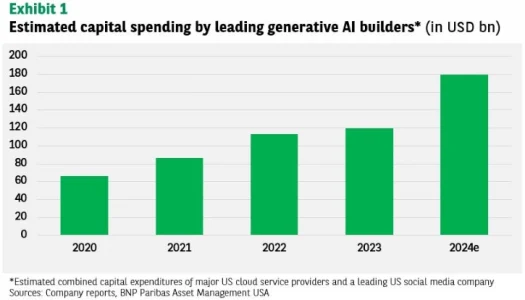The capabilities of artificial intelligence are advancing with the investment focus expanding from computing power to include additional layers of the technologies used to build web or mobile applications. As a result, we are finding more opportunities to invest in stocks of companies that are leaders or beneficiaries of AI.
In our new paper Artificial intelligence is everywhere, we provide an overview of the AI theme and how it is enabled by cloud computing and foundational science and technologies including semiconductors1. It touches on some of the recent advancements as well as the risks and challenges of developing and using AI.
AI is supported by foundational science and technologies such as:
- Cloud computing: Essential for training and hosting AI models
- Internet of Things: Collects data necessary for AI applications
- Semiconductors: Provide the computing power for AI
- Cybersecurity: Protects AI systems and data
- Renewable energy: Helps ensures sustainable power for energy-intensive AI operations.
Use cases for AI are expanding rapidly and include code generation and documentation for developers; automating customer requests; summarising medical reports and simplifying sales and marketing workflow. Such applications improve productivity and efficiency.
Recent advancements in AI technology include making new large language models capable of complex reasoning and problem-solving; making user interactions with AI models more intuitive; and the arrival of next-generation semiconductors to support AI training and inferencing2.
Harnessing the cloud
Cloud computing with advantages including lower costs, scalability, enhanced security and access to advanced technologies provides the necessary infrastructure and resources for AI development and deployment. Thus, investment in digital infrastructure is crucial for supporting AI initiatives. This includes datacentres, networking equipment, and storage systems. There is also growing demand for cooling systems, energy efficiency, and renewable energy sources to power AI datacentres.
The three major US cloud service providers grew cloud revenue by more than 30% over the last four years, surpassing USD 180 billion in combined revenue in 20233. Despite this, there is still a long growth runway: only about 20% of total workloads has migrated to the cloud.
Cloud service providers, large enterprises and government entities are investing heavily to build and equip the datacentres required to support AI initiatives. Our outlook for investments in digital infrastructure over the next several years is positive.
Today, most of the capital investment is focused on computing power, driving demand for semiconductors. Providers of server computers and other datacentre equipment are seeing robust growth. Some of the focus is likely to shift in favour of investment in networking and storage equipment to support training and inferencing of large language and other AI models.
We expect the long-term returns of developing and deploying AI technology to be attractive. Companies that expand beyond the infrastructure layer and create new applications or services are likely to see higher returns on investment. However, the high cost of components is a key variable.

Key investment opportunities
Here are the main areas:
Developers: companies creating AI innovations; cloud service providers training and hosting AI models; semiconductor companies
Foundational technologies: high bandwidth memory and networking chips; semiconductor capital equipment and materials suppliers; foundries; providers of networking and data storage systems; providers of energy efficiency and alternative energy solutions, such as cooling and solar panels
Data providers: companies with proprietary data sets that can be used to train AI models and provide competitive advantages
‘Beneficiaries’: Companies leveraging AI to improve products and services.
Challenges and risks
These include stricter regulations, for example, on copyright and data rights slowing innovation and demand for AI infrastructure.
There is also a need to avoid bias, produce accurate outputs, and ensure that real content can be distinguished from fake information.
Finally, AI systems and data need to be protected from cyberattacks.
Conclusion
Arguably, artificial intelligence is the most significant technology theme since the dawn of the internet age.
As AI technology advances and becomes more pervasive, we believe the investment opportunities among publicly traded equities are broadening. Capitalising on the positive trends while avoiding potential pitfalls will require an active approach to investment management.
Opinion article by Pamela Hegarty and Derek Glynn, BNP Paribas AM
1] Authors: Pamela Hegarty and Derek Glynn
[2] A trained machine learning model can draw conclusions (‘infer’) from brand-new data without examples of the desired result. In other words, inference is an AI model in action.
[3] Compound annual growth rate; analysis based on the installed server base. Source: Bank of America Global Research, “2023 Year Ahead: A Tale of Two Halves”, 4 January 2023.
Disclaimer
Please note that articles may contain technical language. For this reason, they may not be suitable for readers without professional investment experience. Any views expressed here are those of the author as of the date of publication, are based on available information, and are subject to change without notice. Individual portfolio management teams may hold different views and may take different investment decisions for different clients. This document does not constitute investment advice. The value of investments and the income they generate may go down as well as up and it is possible that investors will not recover their initial outlay. Past performance is no guarantee for future returns. Investing in emerging markets, or specialised or restricted sectors is likely to be subject to a higher-than-average volatility due to a high degree of concentration, greater uncertainty because less information is available, there is less liquidity or due to greater sensitivity to changes in market conditions (social, political and economic conditions). Some emerging markets offer less security than the majority of international developed markets. For this reason, services for portfolio transactions, liquidation and conservation on behalf of funds invested in emerging markets may carry greater risk.






